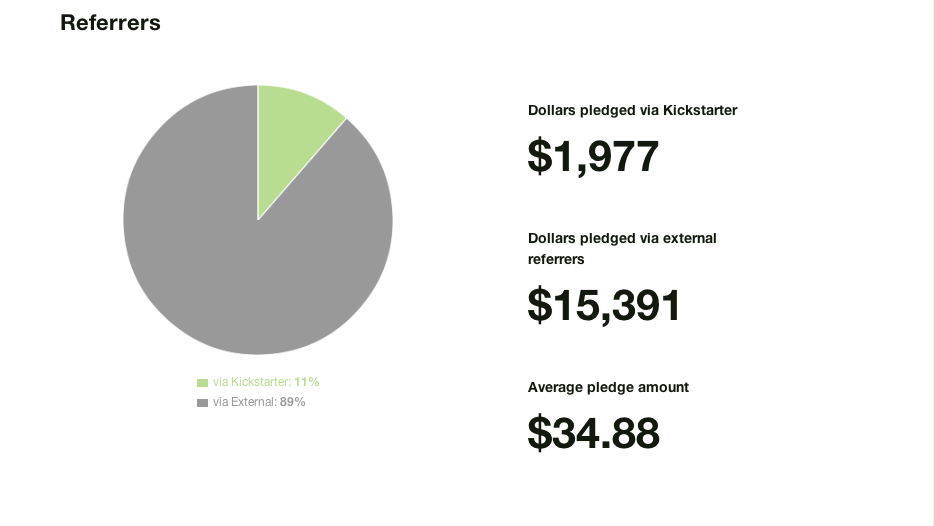Twenty-nine days ago, ProPublica launched a Kickstarter campaign to raise money to hire an intern to help us investigate unpaid internships – an issue that has regained national attention with a flurry of new lawsuitsfollowing a key ruling against Fox Searchlight Pictures.
If our Kickstarter succeeds, our intern will spend the fall semester traveling around the country, tracking these cases and documenting interns’ stories for a microsite on the intern economy. They’ll blog about their journey, the investigative process and their learning experience as an intern — a unique opportunity for our newsroom, and this intern.
We’ll know tomorrow at 9:32 AM ET whether our campaign was a success — as of this writing, we are just over $3,000 away from meeting our goal, and per Kickstarter’s rules, we have to raise the full $22,000, or we get nothing.
Regardless of the outcome, we’ve learned a lot through our first foray into project-based crowdfunding. Here’s some of what we’ve learned:
Your project should be creative and well defined
ProPublica has pondered Kickstarter crowdfunding for years. One of our biggest hurdles is that Kickstarter campaigns work best for concrete, defined projects – a documentary, another season of a podcast or a new level of a video game.
But investigative journalists often don’t know what their reporting will yield. We’re sifting through more than 360 detailed tips from interns or people whose career plans changed because they couldn’t afford to take an unpaid internship, but we don’t yet know exactly what our stories will be.
We were fortunate that for this particular investigation, a substantial piece of the story is hidden in plain sight. Millions of Americans have completed internships, many of which were unpaid. We think capturing their stories and voices through an interactive microsite gives us a tangible way to define the project for our Kickstarter backers and add impact to our overall investigation.
It’s also been tough for us to pitch the internship as an all-or-nothing project — a key Kickstarter funding factor — because we are committed to reporting this story, even if we don’t get to hire our intern. But it’s a Catch-22 we can live with.
(For some other great examples of successful journalism projects, check out Roman Mars’ 99% Invisible, Decode DC and Matter.)
Creative rewards and crunching the numbers
Donor rewards are a crucial part of Kickstarter’s model, and we tried to be creative and strategic about what we offered at different levels. Think $25: get a T-shirt. $50: get early access to a podcast. $5,000: get a project-related celebrity to speak at an event.
The best rewards make backers feel like they’ve benefited from a project they helped make possible. For journalism projects, this could include access to the editorial process, tote bags or t-shirts with custom project designs or special, real-time updates on the reporting.
But you need to make sure to figure out how you’ll pay for your rewards. Does your marketing budget cover them, or will your Kickstarter funds need to cover those costs?
Once you set your fundraising goal, make sure the cost of your rewards fit within your overall budget. If you’re going to offer a T-shirt or a postcard, figure out how much that will cost, including shipping. (We were a bit surprised at how much shipping increased the cost.)
Then compare that unit cost to income projections, and an estimated number of backers. We found it useful to compile all of this in a spreadsheet that let us tweak rewar costs until it fit our budget (we set a limit of 10 percent to be spent on rewards).
Mobilize your readers and networks
How are you going to raise awareness about your Kickstarter campaign? Our game plan included social networking, email outreach and pitching our story as widely as possible. Nearly 90 percent of our donations came from outside the Kickstarter platform, and we had articles or coverage appear in New York Magazine, The Week, Business Insider, New York Times, Wall Street Journal, The Atlantic Wire and more.

We sent a minimum of one, if not two project updates via our social media accounts every day. We emailed all of our existing listservs, crafted project updates for our Kickstarter backers and emailed organizations with an interest in the issue asking if they might be willing to share our project with their listservs.
In short: Marketing a Kickstarter is a close to full-time job, so make sure to budget the time.
Fresh stories were also incredibly helpful for building momentum around the Kickstarter campaign. During the past month, we produced seven pieces on internships, linking to the Kickstarter and encouraging people to back the campaign in each.
In the end, our own site was the third-highest source of donations after Twitter and direct referrals.
Based on our experience, Kickstarter can be a great tool for creative, unique projects, but also tricky for those designed around story-driven projects. But if your newsroom has the time, resources and smart idea, it’s definitely worth an experiment.
A huge thank you to everyone who has donated to our Kickstarter so far. If you’ve ever known, or been, an unpaid intern, we’re sure you can appreciate its importance. And if you haven’t already, please donate in the final stretch to help us achieve our goal!
A big thanks to our Kickstarter team, which included News Apps Fellow Jeremy Merrill, Senior Engagement Editor Amanda Zamora, News Applications Director Scott Klein, ProPublica President Richard Tofel and Explainer Music.












